A Teaching Plan for an Open Class
初中英语优质公开课黄佳妍讲课稿
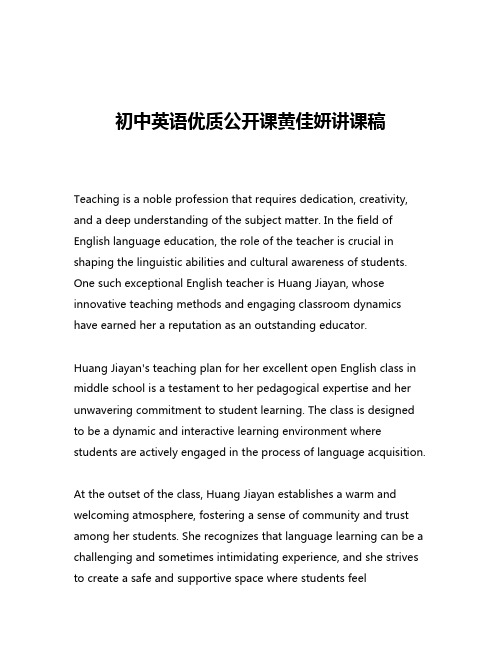
初中英语优质公开课黄佳妍讲课稿Teaching is a noble profession that requires dedication, creativity, and a deep understanding of the subject matter. In the field of English language education, the role of the teacher is crucial in shaping the linguistic abilities and cultural awareness of students. One such exceptional English teacher is Huang Jiayan, whose innovative teaching methods and engaging classroom dynamics have earned her a reputation as an outstanding educator.Huang Jiayan's teaching plan for her excellent open English class in middle school is a testament to her pedagogical expertise and her unwavering commitment to student learning. The class is designed to be a dynamic and interactive learning environment where students are actively engaged in the process of language acquisition.At the outset of the class, Huang Jiayan establishes a warm and welcoming atmosphere, fostering a sense of community and trust among her students. She recognizes that language learning can be a challenging and sometimes intimidating experience, and she strives to create a safe and supportive space where students feelcomfortable expressing themselves and taking risks.One of the key elements of Huang Jiayan's teaching plan is her emphasis on the integration of language skills. Rather than teaching grammar, vocabulary, and communication in isolation, she seamlessly weaves these components together, allowing students to develop a holistic understanding of the English language. This approach not only enhances the students' overall proficiency but also helps them to see the practical applications of what they are learning.Throughout the class, Huang Jiayan utilizes a variety of teaching strategies to cater to the diverse learning styles of her students. She incorporates interactive activities, such as role-playing, group discussions, and problem-solving tasks, which encourage students to actively engage with the material and apply their knowledge in real-world contexts.Moreover, Huang Jiayan's teaching plan places a strong emphasis on the development of critical thinking skills. She challenges her students to analyze complex texts, formulate their own opinions, and engage in meaningful discussions. By fostering these higher-order thinking skills, Huang Jiayan equips her students with the tools they need to become independent and confident language learners.Another notable aspect of Huang Jiayan's teaching plan is her use of technology to enhance the learning experience. She seamlessly integrates digital resources, such as multimedia presentations, online learning platforms, and educational videos, into her lessons. This not only keeps her students engaged and motivated but also helps them to develop the technological skills necessary for success in the 21st century.Huang Jiayan's teaching plan also places a strong emphasis on the importance of cultural awareness and intercultural communication. She encourages her students to explore the rich diversity of the English-speaking world, exposing them to a variety of cultural perspectives and traditions. By doing so, she helps her students to develop a deeper understanding and appreciation of the global nature of the English language.Throughout the class, Huang Jiayan maintains a keen focus on assessment and feedback. She regularly evaluates her students' progress, providing them with constructive and personalized feedback to help them identify their strengths and areas for improvement. This approach not only helps students to track their own learning but also allows Huang Jiayan to continuously refine and improve her teaching strategies.One of the most remarkable aspects of Huang Jiayan's teaching planis her ability to foster a sense of community and collaboration within her classroom. She encourages her students to work together, share their ideas, and support one another in the learning process. This collaborative approach not only enhances the students' language skills but also helps to develop their social and interpersonal abilities.In conclusion, Huang Jiayan's teaching plan for her excellent open English class in middle school is a shining example of the power of effective and innovative teaching. Her dedication to her craft, her deep understanding of the subject matter, and her unwavering commitment to student learning have made her an inspiration to both her colleagues and her students. By continuing to implement her visionary teaching strategies, Huang Jiayan is undoubtedly shaping the future of English language education and inspiring a new generation of language learners.。
第五册Teaching Plan for Lesson
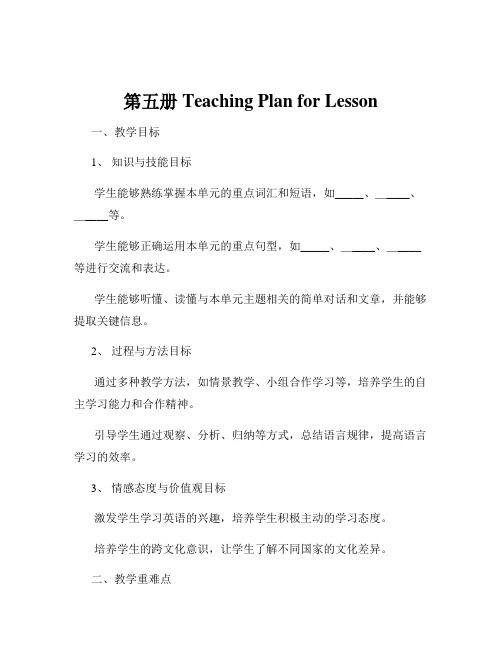
第五册Teaching Plan for Lesson一、教学目标1、知识与技能目标学生能够熟练掌握本单元的重点词汇和短语,如_____、_____、_____等。
学生能够正确运用本单元的重点句型,如_____、_____、_____等进行交流和表达。
学生能够听懂、读懂与本单元主题相关的简单对话和文章,并能够提取关键信息。
2、过程与方法目标通过多种教学方法,如情景教学、小组合作学习等,培养学生的自主学习能力和合作精神。
引导学生通过观察、分析、归纳等方式,总结语言规律,提高语言学习的效率。
3、情感态度与价值观目标激发学生学习英语的兴趣,培养学生积极主动的学习态度。
培养学生的跨文化意识,让学生了解不同国家的文化差异。
二、教学重难点1、教学重点重点词汇和短语的理解与运用。
重点句型的结构和用法。
2、教学难点如何让学生在实际情境中灵活运用所学的词汇和句型。
培养学生的阅读理解和写作能力。
三、教学方法1、情景教学法通过创设生动的情景,让学生在真实的语境中学习和运用语言。
2、任务驱动法给学生布置明确的任务,让学生在完成任务的过程中提高语言能力。
3、小组合作学习法组织学生进行小组合作学习,培养学生的合作精神和交流能力。
四、教学过程1、导入(Warmingup)通过播放一段与本单元主题相关的英语视频或歌曲,引起学生的兴趣,导入新课。
与学生进行简单的交流,如询问学生对相关主题的了解和看法,激活学生的已有知识。
2、词汇学习(Vocabulary)展示本单元的重点词汇,通过图片、实物、动作等方式帮助学生理解词汇的含义。
让学生跟读词汇,纠正发音,然后进行词汇拼写和记忆练习。
3、句型学习(Sentence Patterns)讲解本单元的重点句型,分析句型的结构和用法,举例说明。
组织学生进行句型操练,可以通过模仿、替换、造句等方式,让学生熟练掌握句型。
4、课文学习(Text)让学生听课文录音,理解课文大意,回答一些简单的问题。
教学计划的英文
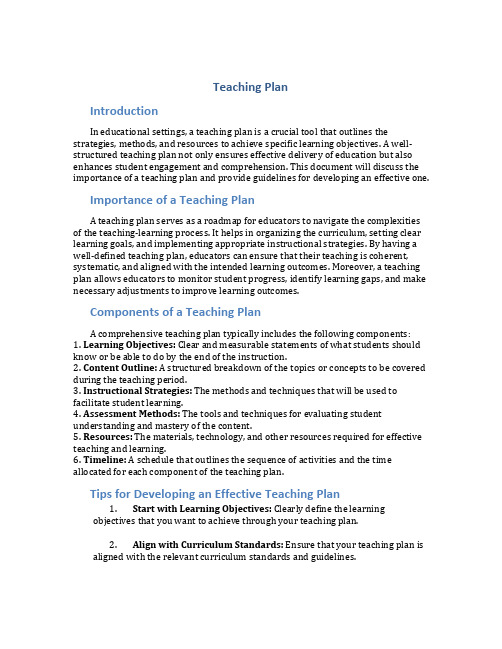
Teaching PlanIntroductionIn educational settings, a teaching plan is a crucial tool that outlines the strategies, methods, and resources to achieve specific learning objectives. A well-structured teaching plan not only ensures effective delivery of education but also enhances student engagement and comprehension. This document will discuss the importance of a teaching plan and provide guidelines for developing an effective one.Importance of a Teaching PlanA teaching plan serves as a roadmap for educators to navigate the complexities of the teaching-learning process. It helps in organizing the curriculum, setting clear learning goals, and implementing appropriate instructional strategies. By having a well-defined teaching plan, educators can ensure that their teaching is coherent, systematic, and aligned with the intended learning outcomes. Moreover, a teaching plan allows educators to monitor student progress, identify learning gaps, and make necessary adjustments to improve learning outcomes.Components of a Teaching PlanA comprehensive teaching plan typically includes the following components:1. Learning Objectives: Clear and measurable statements of what students should know or be able to do by the end of the instruction.2. Content Outline: A structured breakdown of the topics or concepts to be covered during the teaching period.3. Instructional Strategies: The methods and techniques that will be used to facilitate student learning.4. Assessment Methods: The tools and techniques for evaluating student understanding and mastery of the content.5. Resources: The materials, technology, and other resources required for effective teaching and learning.6. Timeline: A schedule that outlines the sequence of activities and the time allocated for each component of the teaching plan.Tips for Developing an Effective Teaching Plan1.Start with Learning Objectives: Clearly define the learningobjectives that you want to achieve through your teaching plan.2.Align with Curriculum Standards: Ensure that your teaching plan isaligned with the relevant curriculum standards and guidelines.3.Consider Student Diversity: Take into account the diverse learningneeds and preferences of your students when designing your teaching plan.e Varied Instructional Strategies: Employ a mix of instructionalstrategies such as lectures, discussions, hands-on activities, and group work to cater to different learning styles.5.Include Assessment Opportunities: Integrate both formative andsummative assessment methods to evaluate student progress andunderstanding.6.Reflect and Revise: Periodically reflect on the effectiveness of yourteaching plan and make necessary revisions based on student feedback and performance.ConclusionIn conclusion, a well-developed teaching plan is essential for effective teaching and learning. By carefully designing and implementing a teaching plan that includes clear learning objectives, instructional strategies, and assessment methods, educators can create a conducive learning environment that promotes student engagement and achievement. Following the guidelines outlined in this document will help educators in developing comprehensive and effective teaching plans to enhance the learning experience for their students.。
A Teaching Plan一份教案设计

A Teaching PlanⅠ.T eaching Contents 教学内容这节课的教学内容是三年级上册的Lesson 17 的Just talk 和Just learn 部分Ⅱ. Teaching Demands 教学目标1.knowledge and skills 知识与技能会听,说,认读单词:leg knee foot会听和说句型:How are you? 你好吗?2.progress and methods 过程与方法我们可以通过听,说,读,角色扮演和游戏的方式来完成这一节课的教学内容。
3.emotions, attitude and values 情感,态度与价值观通过学习这一节课,我们要培养学生在日常生活的卫生保健意识,和注意人身安全Ⅲ.Important and Difficult Teaching Points 教学重难点这一节课的教学重难点是leg ,knee ,foot 这三个单词的读音Ⅳ. Teaching Aids 教学用具准备相关的教学图片和单词卡片Ⅴ. Teaching Procedures 教学过程StepⅠ.Warm-up热身1.Greeting 问候Good morning ,boys and girls .Good morning ,teacher . 2.大家一起唱Hello歌Hello,boys do oh do.Hello,girls do oh do.Hello,teacher do oh do.Hello, hello, hello .StepⅡ.Presentation 新课程现1..课件程现Let’s chant 的内容Leg, leg, how are you?How are you?Knee, knee, how are you ?How are you ?Foot , foot, how are you ?How are you ?I’m fine2.分组练习StepⅢ.Consolidation 巩固Let’s match腿脚膝盖foot leg kneeStepⅣ. Summary 小结本课我们学了几个关于身体部位的英语单词foot ,leg ,knee ,我们要把他们就记住了,会说他们。
小学英语优秀教案英文翻译

小学英语优秀教案英文翻译This document is a translation of an excellent English teaching plan for primary school students. The original plan is full of creative teaching ideas and effective strategies to engage students in learning English. The plan is divided into several sections, each focusing on a specific area of English language learning.Section 1: VocabularyThe first section of the teaching plan is focused on building vocabulary. The teacher employs a range of activities to increase student's vocabulary, including vocabulary flashcards, word association games, and picture matching exercises. Additionally, students read and listen to stories and dialogues, and then identify and define new words. By engaging in these activities, students improve their word recognition and comprehension skills.Section 2: GrammarThe second section of the teaching plan focuses on grammar. The teacher introduces key grammar concepts, such as verb tense and sentence structure, using hands-on activities and visual aids. For example, to teach verb tense, the teacher might use flashcards to introduce the present, past, and future tenses. Theteacher might then lead the class in an activity where they match verbs to the proper tense. Through these activities, students develop a better understanding of how English grammar works.Section 3: PronunciationThe third section of the teaching plan is aimed at improving students' pronunciation. The teacher models correct pronunciation, and leads the class in exercises to practice proper pronunciation. To help students distinguish between different sounds, the teacher might use minimal pairs (words that differ by only one sound), and ask students to identify the different sounds. The teacher might also use tongue twisters to help students improve their pronunciation.Section 4: Reading and WritingThe fourth section of the teaching plan is focused on reading and writing. The teacher encourages students to read English texts, both fiction and non-fiction, as a way of improving their English proficiency. Additionally, the teacher leads the class in guided writing exercises, such as completing sentences or paragraphs, or writing short stories. Through these activities, students improve their reading comprehension and writing skills.Section 5: AssessmentThe final section of the teaching plan is dedicated to assessment. The teacher uses a range of assessment tools, including tests, quizzes, and observations, to measure studentprogress in each area of language learning. The teacher also uses student feedback to identify areas where improvement is needed, and adjusts the teaching plan to better meet student needs.In conclusion, this English teaching plan for primary school students is an excellent resource for teachers looking to engage and empower their students in learning English. The plan is comprehensive, covering all key areas of language learning, and employs a range of strategies and activities to foster language proficiency. By implementing the methods outlined in this teaching plan, teachers can help their students become confident and effective English language learners.。
Unit 3 Reading and Thinking 教案-高中英语人教版(2019)必修第一册
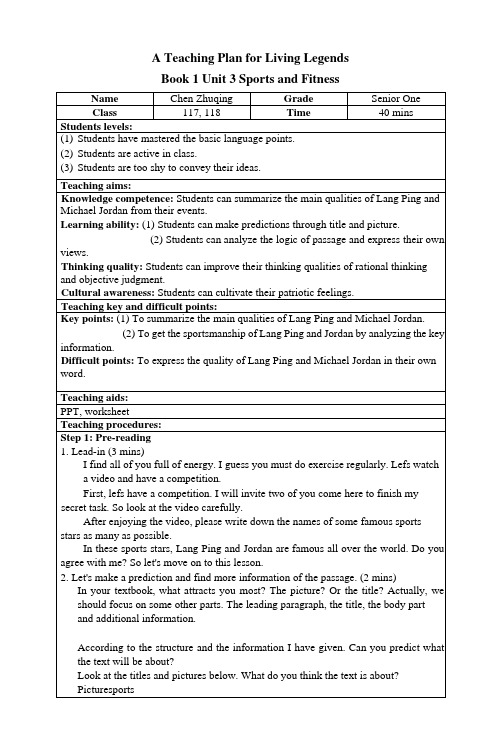
A Teaching Plan for Living Legends Book 1 Unit 3 Sports and FitnessLiving legends & Lang Ping, Michael Jordan Great sports people alivetoday.It is about living legends of sports.Step 2: While-readingActivity 1: Skimming (1 mins)QI: How do you understand the word "legend”?A. A story from ancient times about people and events, that may or may be true;A very famous person, especially in a particular field, who is admired by other people.Q2: How do you understand the “Living Legends of Sports”?“They must be athletes w ho are masters in their sports and also set good examples for others.”Just like Lang Ping and Jordan, they are living legends of sports. First of all, let's know more about Lang Ping.Activity 2: Scanning (6 mins) Scan and answer the questions.Paragraph 1 in body part.QI: What identities(身份)of Lang Ping are mentioned in the passage?Q2: How was Lang Ping's determination tested in the 2015 World Cup?The team that Lang Ping had built was falling apart. One of the best players had been injured, and the team captain had to leave because of heart problems. Losing two important players was a big challenge, but Lang Ping did not lose heart.Q3: After Lang Ping overcame the difficulties, what's the result?In 2015, they were world champions.In 2016, Lang Ping led her volleyball team to Olympic gold in Brazil.Q4: What kind of quality(品质)does Lang Ping possess?sense of national glory/patriotic(爱国的)team spirit determinedset good examples respectable professional • •••••Paragraph 2 in body part.QI: What does the first sentence in the paragraph introducing Michael Jordan mean? It means when Michael Jordan jumped in the air it felt like time had slowed down, because his amazing skills were almost like magic.Q2: Why does the writer mention “the final seconds of a game”?Because in basketball this is an important time where one team could win with a few points at the last moment.Try to summarize the main qualities of a living legends.Activity 2: ExpressingTalk about a model using what you have learnt in class as much as possible. Step 4: HomeworkChoose another living legend and write a composition for “Living Legends”. Try to imitate the structure and language of text.Try to use proper figures of speech and examples.。
教学工作计划书英语
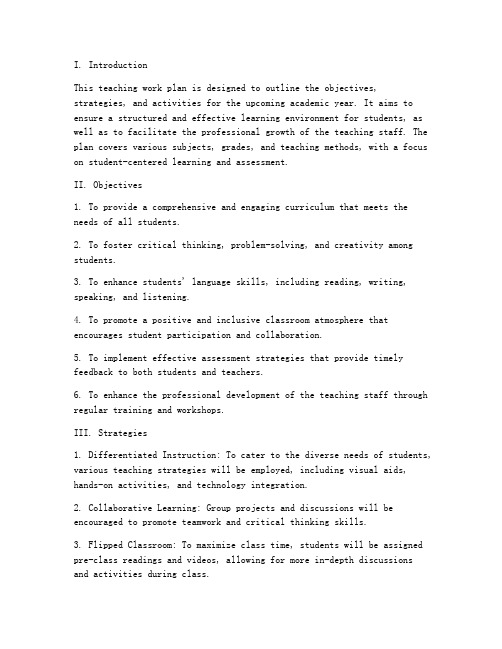
I. IntroductionThis teaching work plan is designed to outline the objectives, strategies, and activities for the upcoming academic year. It aims to ensure a structured and effective learning environment for students, as well as to facilitate the professional growth of the teaching staff. The plan covers various subjects, grades, and teaching methods, with a focus on student-centered learning and assessment.II. Objectives1. To provide a comprehensive and engaging curriculum that meets the needs of all students.2. To foster critical thinking, problem-solving, and creativity among students.3. To enhance students' language skills, including reading, writing, speaking, and listening.4. To promote a positive and inclusive classroom atmosphere that encourages student participation and collaboration.5. To implement effective assessment strategies that provide timely feedback to both students and teachers.6. To enhance the professional development of the teaching staff through regular training and workshops.III. Strategies1. Differentiated Instruction: To cater to the diverse needs of students, various teaching strategies will be employed, including visual aids, hands-on activities, and technology integration.2. Collaborative Learning: Group projects and discussions will be encouraged to promote teamwork and critical thinking skills.3. Flipped Classroom: To maximize class time, students will be assigned pre-class readings and videos, allowing for more in-depth discussionsand activities during class.4. Project-Based Learning: Students will engage in long-term projects that require research, collaboration, and presentation skills.5. Technology Integration: Utilize educational software and online resources to enhance learning experiences and facilitate communication between students and teachers.IV. Activities1. Grade 1-3: Focus on foundational skills in reading, writing, and mathematics, incorporating songs, games, and hands-on activities to make learning fun and engaging.2. Grade 4-6: Introduce more complex concepts in mathematics, science, and social studies, with a focus on inquiry-based learning and critical thinking.3. Grade 7-9: Prepare students for higher education by offering advanced courses in mathematics, science, and language arts, emphasizing research and analytical skills.4. Extracurricular Activities: Organize clubs, sports teams, and arts programs to provide students with opportunities for personal growth and development.5. Parent-Teacher Meetings: Schedule regular meetings to discuss students' progress and address any concerns or questions from parents.V. Assessment1. Formative Assessments: Utilize quizzes, class discussions, and group projects to monitor students' understanding and progress throughout the year.2. Summative Assessments: Administer exams and final projects at the end of each semester to evaluate students' overall performance and achievement.3. Peer Assessments: Encourage students to assess each other's work, promoting self-evaluation and constructive feedback.4. Teacher Assessments: Provide detailed feedback on students' strengths, weaknesses, and areas for improvement.VI. Professional Development1. Conduct regular training sessions for teachers to enhance their teaching skills and knowledge.2. Organize workshops on current educational trends and best practices.3. Encourage teachers to participate in professional conferences and seminars.4. Provide resources and support for teachers to engage in ongoing research and development.VII. ConclusionThis teaching work plan aims to create a supportive and effective learning environment for all students. By implementing these strategies and activities, we hope to foster a love for learning and prepare students for success in their academic and personal lives. Regular evaluation and adjustments will be made to ensure continuous improvement and student growth.。
海南省高中英语 A Teaching Plan for English Writing教案

A Teaching Plan for English WritingBy Chen ChanjuanClass level: Intermediate (Class 20 Senior 3)Main language focus: WritingIntegrated language skills: Reading and speakingTime: 40 minutesTeaching objectives:Students are required to write a letter giving suggestions to one of their peers, and at the end of this lesson, students will be able to1.have a knowledge of different expressions for giving suggestions;2.write a letter on giving suggestions;3.have a general idea of how to write a composition.Teaching aids: Multimedia & blackboardTeaching procedures:Step 1 Pre-writing1.The whole class read one sample passage on giving suggestions for three minutes,and find out the useful expressions of giving suggestions that are frequently used.Hi,Grown-up, (2009 陕西)As a student of your age, I understand your situation. The problem you are facing is common among our teenagers. However, it should be wise not to do anything that may hurt her feelings. Here are a few suggestions.First, it’s advisable to talk more with your mom. Heart to heart talks help you understand each other better. They are also opportunities to let her know your ideas of and attitudes toward many things. Second, you should learn to do your own things well, proving to your mom that you are already a “Grown-up”. It’s even better if you could share more of the housework, such as cleaning, washing and cooking.Hope my ideas will work.YoursDavidStep 2 While-writing1. Students are required to read the requirements of the given topic silently.假如你是Tom,你的美国笔友David向你写信诉说他没有朋友的烦恼。
- 1、下载文档前请自行甄别文档内容的完整性,平台不提供额外的编辑、内容补充、找答案等附加服务。
- 2、"仅部分预览"的文档,不可在线预览部分如存在完整性等问题,可反馈申请退款(可完整预览的文档不适用该条件!)。
- 3、如文档侵犯您的权益,请联系客服反馈,我们会尽快为您处理(人工客服工作时间:9:00-18:30)。
A Teaching Plan for an Open ClassSubject: Unit 20 ArchaeologyInstructor : Wu Yanyu(吴艳玉)from NO 7 Middle School Teaching type: Listening and speakingStudents: class 1, senior 2一. Teaching Objectives:1 .Knowledge Objectives:a) To get students to be familiar with some information about archaeology.b) To master useful words and expressions about curiosity.2 .Ability Objectives:a)To develop students’ listening strategies ability, including metacognitive strategies,cognitive strategies and social/affective strategies.b) To practice expressing curiosity about archaeologicl finds.c) To learn to appreciate archaeologicl discoveries3. Emotional Objective:By learning about the archaeological finds at home and abroad ,the students will come to realize the importance of archaeology and they are cultivated to love archaeology and love our country. 二.Teaching focus:1. To listen to some facts about the excavation of the king of Stonehenge.2. To learn to express curiosity about archaeology.三. Teaching difficult points1. To cultivate students’ listening strategies2. To listen to get the gist of the listening material.四.Teaching methods:1. The Communicative Language Teaching2. Task-based Teaching3. Situational Language Teaching4. PPP(presentation-practice-production)五. Theories applied:the theory of constructivism; focusing on situation ,cooperation and meaning ; the theory of schemata 六.Teaching Aids: Multi-media device and traditional instruction appliances七.Teaching Procedures:Step 1 .Lead-in1.A duty report linked to the Stonehenge.2. Questions:China is a country with an ancient civilization .It has a long history and brilliant culture.In which ways can we learn about its history and culture?Step 2. warming upHave a team competition to get close to archaeology so as to enrich and activate the students’schemata about archaeology .Step 3. Listening1. Pre-listening(in groups)a) Make a prediction about the detailed information of the cominglistening material.b)Guess the main idea of based on the questions given.c) Provide some key and new words2. While-listeningTask 1 Listen to and watch the video clip once. Focus on the Exercise 1 in groups.Task 2 Listen to nd watch the video clip again and complete the multiple- choice in groups.3. Post-listeningTask 3 Suppose you are the archer- the king of Stonehenge who has come back to life. Make an self-introduction individually within agroup according to the video clip you have heard.Step 4. Speaking1.pre-speaking:Task 1: Listen to an English song “Lemon Tree”and complete the lyrics, using I wonder; I wonder how I wonder why.Task 2: Talk about the theme of the song to lead in the topic of curiosity.2.while-speaking :(pair working)Task I : Present the useful expressions about how to express curiosity. Task 2: Situational dialogue in pairs, one act as an archaeologist who has discovered the Mawangdui Han Tombs and the other act as ajournalist sent to interview the archaeologist using the patternsabout curiosity.Step 5.HomeworkWrite a passage to express your understanding of the importance of archaeology according to the questions given.Step 6 Assessment1. The students’ on-the-spot feedbacks are ranked first in assessing the efficiency of this lesson. After-class survey is also necessary and useful.2. I will compare real teaching with teaching plan. Reflect on what should be refined and refreshed.Self-assessmentMark your performance in the blanks to see how well you did in the following items.5= Excellent 4= Good 3= Satisfactory2= Unsatisfactory 1= PoorReflectionI learnt_______________________________________I’d like to know more about______________________________________________ ______________________________________________ I’m still not sure about___________________________Time distribution for this lessonTeaching reflection:From the teaching of this lesson , I ponder a lot over the class atmosphere and teaching effect. Firstly, practising listening through visual divice with a more authentic listening material for the students is really a communicative language teaching, which I think can better inspire and motivate the students’ interest and enthuziasm in the class time. Secondly, Playing some beautiful English song is helpful to enliven the class atmosphere so as to arrest the students’ attention andmake the class dynamic rather than static. Meanwhile, English songs can serve as a genuine listening matters and the lyrics of the songs are genuine language learning materials which are easy to read and remember. They are effective supplementary teaching materials. Thirdly, team work, group work and pair work must be combined so as to lower the difficulty level of the listening task because two heads are better than one. Also, students’ team spirit can be shaped and more importantly, they learn to be cooperative , which is an essential quality for a successful social being.But there are also some problems. The major one is that students are not so well-prepared that they fail to perform their tasks perfectly. Another paradox is the limited time and the large size of class. It is almost impossibe for every student to get a chance to perform their speaking in public, which may inhibit the development of every student. Anyway, I will continue to explore how to improve the students’ listening and speaking competence via video clips ,English films and English songs.。
